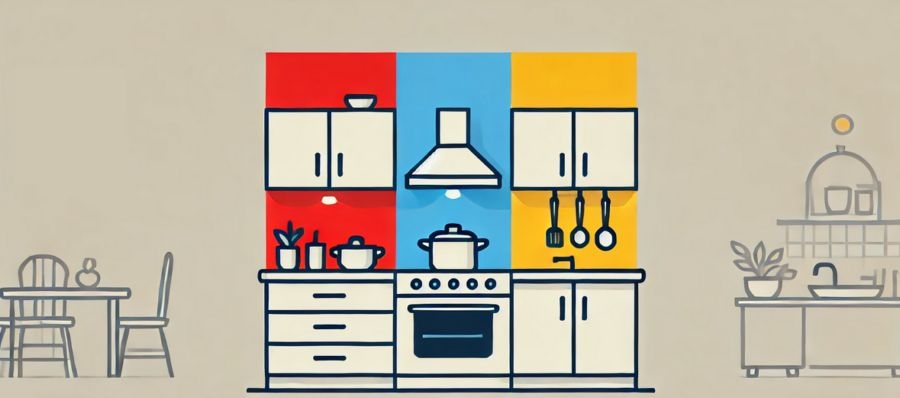Hunger Hues: How Kitchen Colors Shape Appetite, Mood, and Motivation

Why Your Kitchen Isn’t Just a Kitchen
Your kitchen is more than a place for reheating leftovers and pretending you’ll start meal-prepping next week. It’s where life happens—where family squabbles over the last piece of garlic bread, where midnight snack decisions are made, and where coffee-fueled mornings set the tone for the day. But what if the colors surrounding you in this space were secretly influencing how much you eat, how cheerful you feel, and even how willing you are to try cooking something beyond boxed mac and cheese?
Color psychology isn’t just for office walls and fast-food logos. The hues in your kitchen—on walls, cabinets, and even small accents—can have a sneaky but powerful impact on your appetite, mood, and overall productivity. So, before you dip that paintbrush, let’s break down the colors that can turn your kitchen into a joyful, productive space… or one that mysteriously makes you want to take a nap.
Red: The Appetite Accelerator (and Potential Chaos Agent)
If your goal is to eat less, red might not be your best bet. Studies have linked the color red to increased appetite, which is why fast-food chains love to slap it on their branding. There’s something primal about the color—it revs up the metabolism, stimulates hunger, and can even make food seem more appealing.
However, if you have a household prone to arguments over who forgot to put the butter back in the fridge, a fully red kitchen might not be ideal. Red is associated with heightened emotions and even a sense of urgency, which could turn casual dinner conversation into a high-stakes debate over the correct way to load the dishwasher. A little red in accents—like dishware or barstools—can add warmth and energy without making you feel like you're trapped in a high-pressure cooking show.
Blue: Appetite Suppressant or Peaceful Haven?
If you’ve ever noticed that blue is suspiciously absent from most restaurant interiors, there’s a reason. Blue tends to reduce appetite. Evolutionarily speaking, it’s not a color we associate with food (unless you’re on an all-blueberry diet), so it subconsciously signals to our brains that maybe we’re not that hungry after all.
On the flip side, blue can create a calming, serene environment. If your kitchen is a place where you want to slow down, enjoy a cup of tea, and reflect on why you still haven’t mastered sourdough baking, then blue tones might be perfect. Just don’t expect anyone to be overly enthusiastic about second helpings.
Yellow: The Kitchen’s Built-In Morning Person
If your kitchen always feels a little too dreary (especially before caffeine kicks in), yellow might be your new best friend. Bright, cheerful, and warm, yellow is known to boost mood, encourage conversation, and create a welcoming atmosphere. It’s the color equivalent of someone who wakes up at 6 a.m. feeling “refreshed and ready for the day” (and yes, we all secretly resent that person).
That said, too much yellow can be overwhelming. While soft, buttery yellows can make a space feel cozy and inviting, a neon explosion might have you feeling like you’ve wandered into a high-voltage energy drink commercial. Use it wisely, and your kitchen will feel like a sun-drenched café rather than a cautionary tale in overstimulation.
Green: The Fresh Start (or Guilt Trip) Color
Green is the color of nature, health, and every juice cleanse you’ve ever pretended you’d try. It has a natural calming effect and can make your kitchen feel fresh and inviting, especially when paired with natural wood tones and plants.
There’s something about green that makes people think of wholesome, organic meals—so if you’re trying to eat healthier, this could be your secret weapon. However, be warned: if you’re someone who likes a stash of emergency cookies, an overly green kitchen might start whispering, “Wouldn’t you rather have a salad instead?”
White: Clean, Classic… and Maybe a Little Too Sterile?
White kitchens are the go-to choice for people who dream of pristine countertops, sparkling backsplashes, and the illusion that they have their life together. There’s no denying that a white kitchen feels clean and airy—like a place where the scent of freshly baked bread always lingers (even if, in reality, it’s just a strategically placed candle).
But here’s the catch: an all-white kitchen can sometimes feel a little too clinical. While it can make a small space feel bigger and brighter, it can also lack warmth and personality. If you don’t want your kitchen to resemble a high-end laboratory, consider breaking up the starkness with warm wood accents, colorful dishware, or a backsplash that doesn’t scream “hospital chic.”
Gray: The Surprisingly Controversial Choice
Gray has been having a moment in interior design, and for good reason—it’s sophisticated, modern, and pairs well with nearly everything. A gray kitchen can feel sleek and elegant, the kind of place where artisanal coffee is brewed and avocados never go to waste.
However, gray has one potential downside: if it’s too cool-toned, it can make a kitchen feel a bit cold and uninviting. If your goal is to create a space where people gather and linger over meals, a warmer gray with undertones of taupe or beige might be the better bet. Otherwise, you might find your kitchen looking more like a high-end showroom where no one actually cooks.
Black: Bold, Dramatic… and a Magnet for Smudges
A black kitchen is not for the faint of heart. It’s dramatic, moody, and undeniably stylish—like the interior design equivalent of a leather jacket. Black cabinets or walls can add a sense of luxury and depth, making the kitchen feel cozy and intimate rather than stark and unwelcoming.
That said, black surfaces show every fingerprint, smudge, and rogue breadcrumb with startling clarity. If you have kids, pets, or a fondness for cooking that involves flour explosions, be prepared to spend a lot of time wiping things down. But if you love the sleek, high-contrast look, black might just be worth the extra effort.
Lighting: The Secret Weapon of Any Kitchen Makeover
Paint colors aren’t the only thing shaping the way your kitchen feels—lighting plays a huge role too. Even the best color choice can be ruined by bad lighting. Harsh fluorescent lights can make warm colors feel garish, while dim lighting can sap the life out of even the most cheerful yellows.
If you want your kitchen to feel bright and welcoming, opt for warm white LED lights rather than cool-toned ones. Under-cabinet lighting can add depth and functionality, making meal prep less of a shadowy mystery. And if you want to get fancy, installing dimmable lights lets you shift the mood from “morning rush” to “cozy dinner” with the flick of a switch.
Cooking Up the Perfect Color Scheme
So, what’s the best color for your kitchen? It all depends on what you want to feel when you step inside. If you want energy and conversation, go for warm tones. If you want a peaceful retreat, blues and greens might be your match. And if you want your kitchen to feel like a five-star restaurant, maybe it’s time to embrace a bold, dramatic hue.
Ultimately, the best kitchen color is one that makes you happy—whether that means embracing a daring red, a tranquil blue, or just committing to finally repainting those cabinets you’ve been side-eyeing for months. Just remember: no matter what color you choose, someone in your household will still leave dirty dishes in the sink.
|
|




